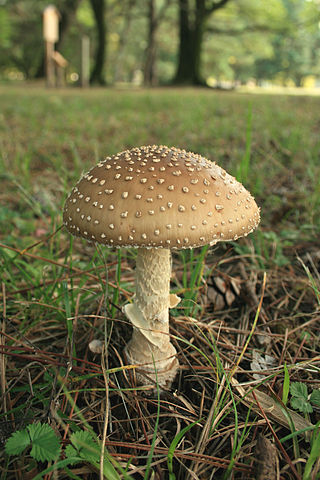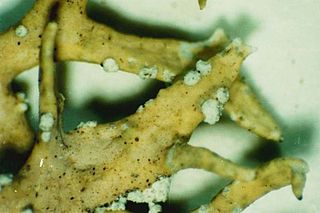
Ascomycota is a phylum of the kingdom Fungi that, together with the Basidiomycota, forms the subkingdom Dikarya. Its members are commonly known as the sac fungi or ascomycetes. It is the largest phylum of Fungi, with over 64,000 species. The defining feature of this fungal group is the "ascus", a microscopic sexual structure in which nonmotile spores, called ascospores, are formed. However, some species of the Ascomycota are asexual, meaning that they do not have a sexual cycle and thus do not form asci or ascospores. Familiar examples of sac fungi include morels, truffles, brewers' and bakers' yeast, dead man's fingers, and cup fungi. The fungal symbionts in the majority of lichens such as Cladonia belong to the Ascomycota.

A lichen is a composite organism that arises from algae or cyanobacteria living among filaments of multiple fungi species in a mutualistic relationship. Lichens have properties different from those of their component organisms. They come in many colors, sizes, and forms and are sometimes plant-like, but are not plants. They may have tiny, leafless branches (fruticose); flat leaf-like structures (foliose); grow crust-like, adhering tightly to a surface (substrate) like a thick coat of paint (crustose); have a powder-like appearance (leprose); or other growth forms.

An antifungal medication, also known as an antimycotic medication, is a pharmaceutical fungicide or fungistatic used to treat and prevent mycosis such as athlete's foot, ringworm, candidiasis (thrush), serious systemic infections such as cryptococcal meningitis, and others. Such drugs are usually obtained by a doctor's prescription, but a few are available over the counter (OTC).

A conidium, sometimes termed an asexual chlamydospore or chlamydoconidium (pl. chlamydoconidia), is an asexual, non-motile spore of a fungus. The word conidium comes from the Ancient Greek word for dust, κόνις (kónis). They are also called mitospores due to the way they are generated through the cellular process of mitosis. The two new haploid cells are genetically identical to the haploid parent, and can develop into new organisms if conditions are favorable, and serve in biological dispersal.

Fungal infection, also known as mycosis, is disease caused by fungi. Different types are traditionally divided according to the part of the body affected; superficial, subcutaneous, and systemic. Superficial fungal infections include common tinea of the skin, such as tinea of the body, groin, hands, feet and beard, and yeast infections such as pityriasis versicolor. Subcutaneous types include eumycetoma and chromoblastomycosis, which generally affect tissues in and beneath the skin. Systemic fungal infections are more serious and include cryptococcosis, histoplasmosis, pneumocystis pneumonia, aspergillosis and mucormycosis. Signs and symptoms range widely. There is usually a rash with superficial infection. Fungal infection within the skin or under the skin may present with a lump and skin changes. Pneumonia-like symptoms or meningitis may occur with a deeper or systemic infection.

Dermatophytosis, also known as ringworm, is a fungal infection of the skin. Typically it results in a red, itchy, scaly, circular rash. Hair loss may occur in the area affected. Symptoms begin four to fourteen days after exposure. Multiple areas can be affected at a given time.

Onychomycosis, also known as tinea unguium, is a fungal infection of the nail. Symptoms may include white or yellow nail discoloration, thickening of the nail, and separation of the nail from the nail bed. Toenails or fingernails may be affected, but it is more common for toenails. Complications may include cellulitis of the lower leg. A number of different types of fungus can cause onychomycosis, including dermatophytes and Fusarium. Risk factors include athlete's foot, other nail diseases, exposure to someone with the condition, peripheral vascular disease, and poor immune function. The diagnosis is generally suspected based on the appearance and confirmed by laboratory testing.
Fungal keratitis is a fungal infection of the cornea, which can lead to blindness. It generally presents with a red, painful eye and blurred vision. There is also increased sensitivity to light, and excessive tears or discharge.

Haloprogin is an antifungal drug used to treat athlete's foot and other fungal infections. It is marketed in creams under the trade names Halotex, Mycanden, Mycilan, and Polik.

Dikarya is a subkingdom of Fungi that includes the divisions Ascomycota and Basidiomycota, both of which in general produce dikaryons, may be filamentous or unicellular, but are always without flagella. The Dikarya are most of the so-called "higher fungi", but also include many anamorphic species that would have been classified as molds in historical literature. Phylogenetically the two divisions regularly group together. In a 1998 publication, Thomas Cavalier-Smith referred to this group as the Neomycota.
Phyllosticta palmetto is a fungal plant pathogen infecting coconuts.
Elsinoe rosarum, Anthracnose, is a fungal plant pathogen. It is a condition found on roses, causing leaves to have irregular dark margins and spots. The disease usually appears during wet weather.
Phoma tracheiphila is a fungal plant pathogen. It causes a disease known as Mal secco on citrus trees. It occurs in dry, cool climates such as the Mediterranean, Black Sea and Asia Minor. It forms pycniospores that are carried short distances by rain, or by wind to new leaves, where germinated hyphae invade stomata or more likely fresh wounds.

Naftifine hydrochloride is an allylamine antifungal drug for the topical treatment of tinea pedis, tinea cruris, and tinea corporis.

Soredia are common reproductive structures of lichens. Lichens reproduce asexually by employing simple fragmentation and production of soredia and isidia. Soredia are powdery propagules composed of fungal hyphae wrapped around cyanobacteria or green algae. These can be either scattered diffusely across the surface of the lichen's thallus, or produced in localized structures called soralia. Fungal hyphae make up the basic body structure of lichen. The soredia are released through openings in the upper cortex of the lichen structure. After their release, the soredia disperse to establish the lichen in a new location.

A fungus is any member of the group of eukaryotic organisms that includes microorganisms such as yeasts and molds, as well as the more familiar mushrooms. These organisms are classified as a kingdom, separately from the other eukaryotic kingdoms, which by one traditional classification include Plantae, Animalia, Protozoa, and Chromista.

Sabouraud agar or Sabouraud dextrose agar (SDA) is a type of agar growth medium containing peptones. It is used to cultivate dermatophytes and other types of fungi, and can also grow filamentous bacteria such as Nocardia. It has utility for research and clinical care.
David Leslie Hawksworth is a British mycologist and lichenologist currently with a professorship in the Universidad Complutense de Madrid in Madrid, Spain and also a Scientific Associate of The Natural History Museum in London. In 2002, he was honoured with an Acharius Medal by the International Association for Lichenology. He married Patricia Wiltshire, a leading forensic ecologist and palynologist in 2009. As of 2022, he is the Editor-in-Chief of the journals IMA Fungus and Biodiversity and Conservation.
Roy Watling, PhD., DSc, FRSE, F.I.Biol., C.Biol., FLS is a Scottish mycologist who has significant contributions to the study of fungi both in identification of new species and correct taxonomic placement, as well as in fungal ecology.

Saccharomyceta is a clade of fungi containing Pezizomycotina and Saccharomycotina, or all Ascomycete fungi except Taphrinomycotina according to the 2007 fungal phylogeny "The Mycota: A Comprehensive Treatise on Fungi as Experimental Systems for Basic and Applied Research" and Tedersoo et al. 2018.













